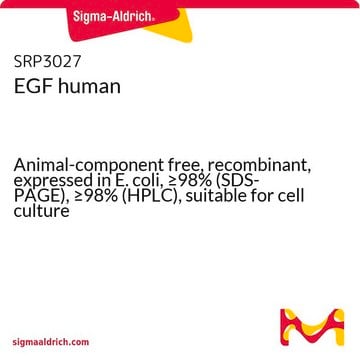E4127
Epidermal Growth Factor from murine submaxillary gland
EGF, suitable for cell culture
Synonym(s):
EGF, Epidermal cell growth factor
About This Item
Recommended Products
biological source
mouse submaxillary glands
form
lyophilized powder
potency
0.1-10 ng/mL ED50/EC50
quality
endotoxin tested
mol wt
6 kDa
packaging
pkg of 0.1 and 5X0.1 mg
storage condition
avoid repeated freeze/thaw cycles
technique(s)
cell culture | mammalian: suitable
impurities
≤50 EU/vial (LAL test)
color
white to off-white
solubility
water: soluble, clear, colorless (1 vial is reconstituted with 0.5 mL of 0.85% NaCl)
UniProt accession no.
storage temp.
2-8°C
Gene Information
mouse ... Egf(13645)
Looking for similar products? Visit Product Comparison Guide
Related Categories
Application
Biochem/physiol Actions
Components
Caution
Preparation Note
Analysis Note
recommended
Storage Class Code
11 - Combustible Solids
WGK
WGK 2
Flash Point(F)
Not applicable
Flash Point(C)
Not applicable
Personal Protective Equipment
Certificates of Analysis (COA)
Search for Certificates of Analysis (COA) by entering the products Lot/Batch Number. Lot and Batch Numbers can be found on a product’s label following the words ‘Lot’ or ‘Batch’.
Already Own This Product?
Find documentation for the products that you have recently purchased in the Document Library.
Customers Also Viewed
Our team of scientists has experience in all areas of research including Life Science, Material Science, Chemical Synthesis, Chromatography, Analytical and many others.
Contact Technical Service







